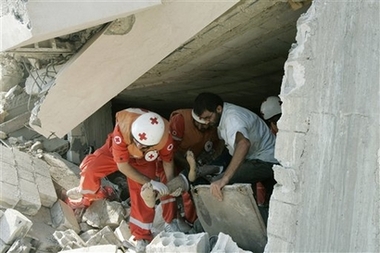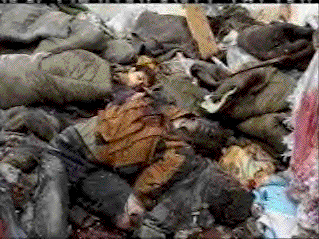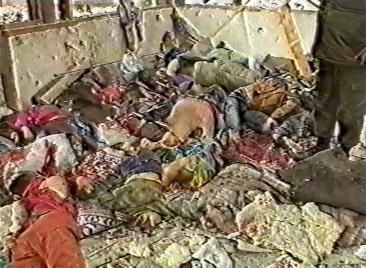July 30, 2006 "On 18 April 1996, during a massive Israeli military offensive on Lebanon code-named "Operation Grapes of Wrath," approximately 800 civilians were sheltering in a United Nations Interim Forces in Lebanon (UNIFIL) base in the village of Qana, South Lebanon. They had assumed - incorrectly - that since international law strictly prohibits the targeting of civilian structures and UN facilities they would be safe under UNIFIL's protection. Just after 2 PM on April 18, a barrage of proximity-fuse shells crashed directly into the pre-fabricated building. Minutes later 106 people lay dead, many burned and dismembered beyond recognition. On 25 April 1996 the UN General Assembly adopted a resolution (UNGA Res. A/RES/50/22 C) characterizing Israel's actions in the "Grapes of Wrath" offensive as "grave violations of international laws relating to the protection of civilians during war." Then UN Secretary General Boutros Boutros Ghali appointed a team to investigate Israel's bombing of the UNIFIL compound. The team was composed of military experts and headed by the Dutch General Franklin Van Kappen. It conducted an official on-site investigation of the Qana incident, interviewed all available witnesses, including UNIFIL staff and Israeli officials, and obtained maps and ballistic evidence. According to experts familiar with this UN investigation, the initial report concluded that the shelling and killing of 106 civilians inside the UNIFIL compound by Israel was deliberate and that there was no possibility of an accident. When former UN Secretary General Boutros Ghali wanted to publish the report, he was threatened that this would cost him his job and forced to publish a revised report. This report concluded that "while the possibility cannot be ruled out completely, it is unlikely that the shelling of the UNIFIL compound was the result of gross technical and/or procedural error." The Van Knappen report also indicated that IDF officials of "some seniority" were involved in orders to fire upon the base, which they knew was sheltering hundreds of civilians. International human rights organizations also conducted investigations and concluded that the shelling of the UNIFIL compound was most likely deliberate, not mistaken. The United States and Israel vigorously contended that the attack had been an unfortunate mistake. No further action was taken by the United Nations. Moreover, the United Nations has yet to act upon a petition filed by families of the victims of Qana with the UN Human Rights Commission. The families' petition requests the UN to re-open its investigation." Will the Qana II massacre, which was also the result of an IAF attack on a UN facility, at the same location, be the object of a war crimes investigation? The underlying pattern cynically replicates the 1996 "Grapes of Wrath Operation".
PHOTOGRAPHIC EVIDENCE OF ISRAELI CRIMES AGAINST HUMANITY Qana is the place where, according to the Fourth Gospel, Jesus performed his first miracle, the turning of a large quantity of water into wine at a wedding feast (John 2:1-11) Qana Massacre I www.uruknet.info?p=25242
Global Research Editorial Note
On the 30th of July 2006, a massacre was perpetrated at the village of Qana in southern Lebanon. The victims had taken refuge at a United Nations shelter, which suggests that the UNIFIL facility was the object of a specific IAF attack.
Ten years ago, on April 18, 1996, at the same village in Southern Lebanon, the Israeli Air force bombed and killed 106 Lebanese civilians who had taken refuge in a UN shelter inside the UNIFIL compound.
The July 2006 attack on the Qana UN shelter replicates with meticulous accuracy the April 1996 IAF operation, entitled as "The Grapes of Wrath".
The Badil Resource Center published the following report on the 1996 Qana Massacre, which was the object of a UN investigation.
The initial report concluded that the shelling of the shelter inside the UNIFIL compound by Israel was deliberate. "When former UN Secretary General Boutros Ghali wanted to publish the report, he was threatened that this would cost him his job and forced to publish a revised report."
Photographic evidence of the Qana I is provided below by from www.israeltolebanon.info
The 1996 UN Investigation into Israel's War Crime at Qana, South Lebanon (excerpt of Badil Report)
(Badil Resource Center, http://www.globalresearch.ca/articles/BAD205A.html)
Michel Chossudovsky, Global Research, 30 July 2006
www.fromisraeltolebanon.info
Qana Massacre II
30 July 2006
55 Civilians massacred including 27 children in a shelter
(Early reports) 


















18 April, 1996
The Israeli Air force bombed and killed 106 Lebanese civilians (almost all either women, children or old men) who had taken refuge in a UN shelter in the village of QANA. A further 110 civilians were injured






www.globalresearch.ca/index.php?context=viewArticle&code=20060730&articleId=2859
